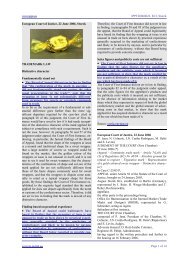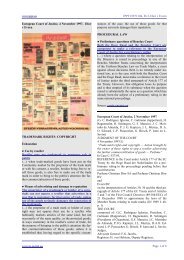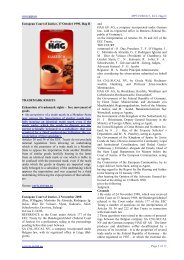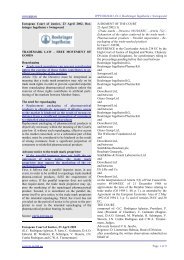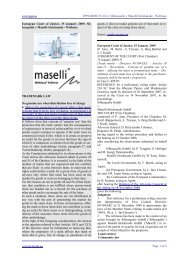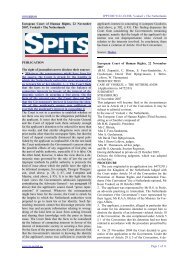Case C-251/95 SABEL - IPPT.eu
Case C-251/95 SABEL - IPPT.eu
Case C-251/95 SABEL - IPPT.eu
Create successful ePaper yourself
Turn your PDF publications into a flip-book with our unique Google optimized e-Paper software.
www.ippt.<strong>eu</strong><br />
European Court of Justice, 11 November 1997,<br />
Puma v Sabel<br />
TRADEMARK LAW<br />
v<br />
Risk of confusion and association<br />
● Risk of association is no alternative for the wording<br />
‘likelihood of confusion’, but serves to define its<br />
scope<br />
In that connection, it is to be remembered that Article<br />
4(1)(b) of the Directive is designed to apply only if, by<br />
reason of the identity or similarity both of the marks<br />
and of the goods or services which they designate, 'there<br />
exists a likelihood of confusion on the part of the<br />
public, which includes the likelihood of association<br />
with the earlier trade mark‘. It follows from that wording<br />
that the concept of likelihood of association is not<br />
an alternative to that of likelihood of confusion, but<br />
serves to define its scope. The terms of the provision<br />
itself exclude its application where there is no likelihood<br />
of confusion on the part of the public.<br />
<strong>IPPT</strong>19971111, ECJ, Puma v Sabel<br />
● Risk of confusion is to be appreciated globally,<br />
taking into account all relevant facts<br />
As pointed out in paragraph 18 of this judgment, Article<br />
4(1)(b) of the Directive does not apply where there<br />
is no likelihood of confusion on the part of the public.<br />
In that respect, it is clear from the tenth recital in the<br />
preamble to the Directive that the appreciation of the<br />
likelihood of confusion 'depends on numerous elements<br />
and, in particular, on the recognition of the trade mark<br />
on the market, of the association which can be made<br />
with the used or registered sign, of the degree of similarity<br />
between the trade mark and the sign and between<br />
the goods or services identified‘. The likelihood of confusion<br />
must therefore be appreciated globally, taking<br />
into account all factors relevant to the circumstances of<br />
the case.<br />
● Similarity should be based on global impression<br />
that trademarks give, taking into account their distinctive<br />
and dominant components<br />
That global appreciation of the visual, aural or conceptual<br />
similarity of the marks in question, must be based<br />
on the overall impression given by the marks, bearing<br />
in mind, in particular, their distinctive and dominant<br />
components. The wording of Article 4(1)(b) of the Directive<br />
— '... there exists a likelihood of confusion on<br />
the part of the public ...‘ — shows that the perception<br />
of marks in the mind of the average consumer of the<br />
type of goods or services in question plays a decisive<br />
role in the global appreciation of the likelihood of confusion.<br />
The average consumer normally perceives a<br />
mark as a whole and does not proceed to analyse its<br />
various details.<br />
● Decisive role for impression that stays with average<br />
consumer that usually will see a trademark as a<br />
whola and will not pay attention to details<br />
In that perspective, the more distinctive the earlier<br />
mark, the greater will be the likelihood of confusion. It<br />
is therefore not impossible that the conceptual similarity<br />
resulting from the fact that two marks use images<br />
with analogous semantic content may give rise to a<br />
likelihood of confusion where the earlier mark has a<br />
particularly distinctive character, either per se or because<br />
of the reputation it enjoys with the public.<br />
● Likelihood of confusion rises as the imaginative<br />
content of the older trademark is stronger<br />
However, in circumstances such as those in point in the<br />
main proceedings, where the earlier mark is not especially<br />
well known to the public and consists of an<br />
image with little imaginative content, the mere fact that<br />
the two marks are conceptually similar is not sufficient<br />
to give rise to a likelihood of confusion.<br />
● No risk of confusion when the public would only<br />
associate both trademarks with one another because<br />
of their analogous semantic content<br />
The answer to the national court's question must therefore<br />
be that the criterion of 'likelihood of confusion<br />
which includes the likelihood of association with the<br />
earlier mark‘ contained in Article 4(1)(b) of the Directive<br />
is to be interpreted as meaning that the mere<br />
association which the public might make between two<br />
trade marks as a result of their analogous semantic content<br />
is not in itself a sufficient ground for concluding<br />
that there is a likelihood of confusion within the meaning<br />
of that provision.<br />
Source: curia.<strong>eu</strong>ropa.<strong>eu</strong><br />
European Court of Justice, 11 November 1997<br />
(G. C. Rodríguez Iglesias, C. Gulmann (rapport<strong>eu</strong>r), H.<br />
Ragnemalm, M. Wathelet, G. F. Mancini, J. C. Moitinho<br />
de Almeida, P. J. G. Kapteyn, J. L. Murray, D. A.<br />
O. Edward, J.-P. Puissochet, G. Hirsch, P. Jann en L.<br />
Sevón)<br />
JUDGMENT OF THE COURT<br />
11 November 1997(1)<br />
Directive 89/104/EEC — Approximation of laws relating<br />
to trade marks — 'Likelihood of confusion which<br />
includes the likelihood of association‘<br />
In <strong>Case</strong> C-<strong>251</strong>/<strong>95</strong>,<br />
www.ip-portal.<strong>eu</strong> Page 1 of 5
www.ippt.<strong>eu</strong><br />
REFERENCE to the Court under Article 177 of the EC<br />
Treaty by the Bundesgerichtshof for a preliminary ruling<br />
in the proceedings pending before that court<br />
between<br />
<strong>SABEL</strong> BV<br />
and<br />
Puma AG, Rudolf Dassler Sport<br />
on the interpretation of Article 4(1)(b) of First Council<br />
Directive 89/104/EEC of 21 December 1988 to approximate<br />
the laws of the Member States relating to<br />
trade marks (OJ 1989 L 40, p.1),<br />
THE COURT,<br />
composed of: G.C. Rodríguez Iglesias, President, C.<br />
Gulmann (Rapport<strong>eu</strong>r), H. Ragnemalm and M. Wathelet,<br />
(Presidents of Chambers), G.F. Mancini, J.C.<br />
Moitinho de Almeida, P.J.G. Kapteyn, J.L. Murray,<br />
D.A.O. Edward, J.-P. Puissochet, G. Hirsch, P. Jann<br />
and L. Sevón, Judges,<br />
Advocate General: F.G. Jacobs,<br />
Registrar: H.A. Rühl, Principal Administrator,<br />
after considering the written observations submitted on<br />
behalf of:<br />
Puma AG, Rudolf Dassler Sport, by W. Hufnagel, Patentanwalt,<br />
the French Government, by C. de Salins, Deputy Director<br />
in the Legal Affairs Department of the Ministry of<br />
Foreign Affairs, and P. Martinet, Secretary for Foreign<br />
Affairs in that Ministry, acting as Agents,<br />
the Netherlands Government, by A. Bos, Legal Adviser<br />
in the Ministry of Foreign Affairs, acting as Agent,<br />
the United Kingdom Government, by L. Nicoll, of the<br />
Treasury Solicitor's Department, acting as Agent, assisted<br />
by M. Silverleaf, Barrister,<br />
the Commission of the European Communities, by J.<br />
Grunwald, Legal Adviser, and B.J. Drijber, of its Legal<br />
Service, acting as Agents,<br />
having regard to the Report for the Hearing,<br />
after hearing the oral observations of <strong>SABEL</strong> BV, represented<br />
by R.E.P. de Ranitz, of The Hague Bar; of the<br />
Belgian Government, represented by A. Braun, of the<br />
Brussels Bar; of the French Government, represented<br />
by P. Martinet; of the Luxembourg Government, represented<br />
by N. Decker, of the Luxembourg Bar; of the<br />
United Kingdom Government, represented by L.<br />
Nicoll, assisted by M. Silverleaf; and of the Commission,<br />
represented by J. Grunwald, at the hearing on 28<br />
January 1997,<br />
after hearing the Opinion of the Advocate General at<br />
the sitting on 29 April 1997,<br />
gives the following<br />
Judgment<br />
By order of 29 June 19<strong>95</strong>, received at the Court on 20<br />
July 19<strong>95</strong>, the Bundesgerichtshof (Federal Court of<br />
Justice) referred to the Court for a preliminary ruling<br />
under Article 177 of the EC Treaty a question on the<br />
interpretation of Article 4(1)(b) of First Council Directive<br />
89/104/EEC of 21 December 1988 to approximate<br />
the laws of the Member States relating to trade marks<br />
(OJ 1989 L 40, p. 1, hereinafter 'the Directive‘).<br />
That question was raised in proceedings between the<br />
Dutch company <strong>SABEL</strong> BV (hereinafter '<strong>SABEL</strong>‘) and<br />
<strong>IPPT</strong>19971111, ECJ, Puma v Sabel<br />
the German company Puma AG, Rudolf Dassler Sport<br />
(hereinafter 'Puma‘) concerning an application to register<br />
the IR mark 540 894, depicted below,<br />
in Germany, inter alia for goods in classes 18 'Leather<br />
and imitation leather, products made therefrom not included<br />
in other classes; bags and handbags‘ and 25<br />
'Clothing, including tights, hosiery, belts, scarves,<br />
ties/cravats and braces; footwear; hats‘.<br />
Puma lodged opposition to the registration of that mark<br />
on the ground, in particular, that it was the proprietor of<br />
the pictorial mark depicted below,<br />
which was of earlier priority and registered in Germany<br />
(under No 1 106 066), inter alia for 'leather and imitation<br />
leather, goods made therefrom (bags) and articles<br />
of clothing‘.<br />
The D<strong>eu</strong>tsches Patentamt (German Patent Office) considered<br />
there to be no resemblance for the purposes of<br />
trade-mark law between the two marks and rejected the<br />
opposition. Puma therefore appealed to the Bundespatentgericht<br />
(Federal Patents Court) which partially<br />
upheld its application and held that there was a resemblance<br />
between the two marks with respect to <strong>SABEL</strong>'s<br />
goods in classes 18 and 25, which it regarded as being<br />
identical or similar to the goods on the list of articles<br />
covered by the Puma mark. <strong>SABEL</strong> then appealed to<br />
the Bundesgerichtshof for annulment of the decision<br />
refusing its application.<br />
The Bundesgerichtshof provisionally considered that,<br />
applying the principles applied hitherto under German<br />
law for determining whether there is a likelihood of<br />
confusion for trade-mark purposes, no such likelihood<br />
existed as regards the two marks in question.<br />
The criteria applied by the Bundesgerichtshof in order<br />
to reach that provisional conclusion are, in essence, as<br />
follows:<br />
In determining whether there is a likelihood of confusion,<br />
the court must focus on the overall impression<br />
made by the respective signs. It is not permissible to<br />
isolate one element out of a graphic ensemble and to<br />
restrict examination of the likelihood of confusion to<br />
that element alone. However, an individual component<br />
may be recognized as having a particularly distinctive<br />
character which characterizes the sign as a whole, and,<br />
consequently, a likelihood of confusion may be found<br />
to exist if another party's sign resembles the whole of<br />
the sign so characterized. Even in such a case, however,<br />
the two signs must be compared in their entirety and<br />
the comparison must not be confined to their individual<br />
(characterizing) elements.<br />
www.ip-portal.<strong>eu</strong> Page 2 of 5
www.ippt.<strong>eu</strong><br />
A sign may have a particularly distinctive character either<br />
per se or because of the reputation the mark enjoys<br />
with the public. The more distinctive its character, the<br />
greater the risk of confusion. However, since no submission<br />
had been made on that point in the present<br />
case, the starting point for examining the similarity of<br />
the two marks is that the earlier mark has normal distinguishing<br />
characteristics.<br />
The assessment of whether an element has such significance<br />
as to characterize the sign as a whole is,<br />
essentially, a matter for the court called upon to adjudicate<br />
on the substance of the case, subject however to its<br />
observing the rules of logic and common sense. The<br />
Bundespatentgericht cannot be criticized in law for<br />
stressing the importance of the pictorial component of<br />
the <strong>SABEL</strong> mark and considering that the textual component<br />
of the mark was of only secondary importance.<br />
Strict criteria must be applied with respect to the likelihood<br />
of confusion between pictorial components which<br />
are basically descriptive and have little imaginative<br />
content. The depiction of a bounding feline is a pictorial<br />
component which closely follows a natural model<br />
and reproduces the bounding motion typical of such<br />
animals. The particular features of the depiction of the<br />
bounding feline in the Puma mark, for example its depiction<br />
as a silhouette, are not reproduced in the<br />
<strong>SABEL</strong> mark. The fact that there is an analogy between<br />
the pictorial components of the two marks can therefore<br />
not be adduced as a ground for finding that there is a<br />
likelihood of confusion.<br />
None the less, the Bundesgerichtshof seeks to ascertain<br />
the importance to be accorded to the semantic content<br />
of the marks (in the present case, a 'bounding feline‘) in<br />
determining the likelihood of confusion. That difficulty<br />
is occasioned, in particular, by the ambiguous wording<br />
of Article 4(1)(b) of the Directive, in terms of which<br />
the likelihood of confusion 'includes the likelihood of<br />
association with the earlier trade mark‘. The question<br />
therefore arises for the national court whether the mere<br />
association which the public might make between the<br />
two marks, through the idea of a 'bounding feline‘, justifies<br />
refusing protection to the <strong>SABEL</strong> mark in<br />
Germany for products similar to those on the list of articles<br />
covered by Puma's priority mark.<br />
The Directive, which was implemented in Germany by<br />
the Gesetz über den Schutz von Marken und sonstigen<br />
Kennzeichen (Law on the Protection of Trade Marks<br />
and Other Signs) of 25 October 1994 (BGBl I, p.<br />
3082), contains, in Article 4(1)(b), the following provision:<br />
'A trade mark shall not be registered or, if registered,<br />
shall be liable to be declared invalid:<br />
(a) ...<br />
(b) if because of its identity with, or similarity to, the<br />
earlier trade mark and the identity or similarity of the<br />
goods or services covered by the trade marks, there exists<br />
a likelihood of confusion on the part of the public,<br />
which includes the likelihood of association with the<br />
earlier trade mark.‘<br />
The tenth recital in the preamble to the Directive states:<br />
<strong>IPPT</strong>19971111, ECJ, Puma v Sabel<br />
'Whereas the protection afforded by the registered trade<br />
mark, the function of which is in particular to guarantee<br />
the trade mark as an indication of origin, is absolute in<br />
the case of identity between the mark and the sign and<br />
goods or services; whereas the protection applies also<br />
in case of similarity between the mark and the sign and<br />
the goods or services; whereas it is indispensable to give<br />
an interpretation of the concept of similarity in<br />
relation to the likelihood of confusion; whereas the likelihood<br />
of confusion, the appreciation of which<br />
depends on numerous elements and, in particular, on<br />
the recognition of the trade mark on the market, of the<br />
association which can be made with the used or registered<br />
sign, of the degree of similarity between the trade<br />
mark and the sign and between the goods or services<br />
identified, constitutes the specific condition for such<br />
protection; whereas the ways in which likelihood of<br />
confusion may be established, and in particular the<br />
onus of proof, are a matter for national procedural rules<br />
which are not prejudiced by the directive‘.<br />
The Bundesgerichtshof decided to stay proceedings and<br />
to refer the following question to the Court for a preliminary<br />
ruling:<br />
'With reference to the interpretation of Article 4(1)(b)<br />
of the First Council Directive of 21 December 1988 to<br />
approximate the laws of the Member States relating to<br />
trade marks, is it sufficient for a finding that there is a<br />
likelihood of confusion between a sign composed of text<br />
and picture and a sign consisting merely of a picture,<br />
which is registered for identical and similar goods and<br />
is not especially well known to the public, that the two<br />
signs coincide as to their semantic content (in this case,<br />
a bounding feline)?<br />
What is the significance in this connection of the wording<br />
of the Directive, in terms of which the likelihood of<br />
confusion includes the likelihood that a mark may be<br />
associated with an earlier mark?’<br />
In its question the Bundesgerichtshof is essentially asking<br />
whether the criterion of the 'likelihood of confusion<br />
... which includes the likelihood of association with the<br />
earlier trade mark‘ contained in Article 4(1)(b) of the<br />
Directive is to be interpreted as meaning that the mere<br />
association which the public might make between the<br />
two marks as a result of a resemblance in their semantic<br />
content, is a sufficient ground for concluding that there<br />
exists a likelihood of confusion within the meaning of<br />
that provision, taking into account that one of those<br />
marks is composed of a combination of a word and a<br />
picture, whilst the other, consisting merely of a picture,<br />
is registered for identical and similar goods, and is not<br />
especially well known to the public.<br />
Article 4(1)(b) of the Directive, which sets out the additional<br />
grounds on which registration may be refused or<br />
a registered mark declared invalid in the event of conflict<br />
with earlier marks, provides that a trade mark<br />
conflicts with an earlier trade mark if, because of the<br />
identity or similarity of both the trade marks and the<br />
goods or services covered, there exists a likelihood of<br />
confusion on the part of the public, which includes the<br />
likelihood of association between the two marks.<br />
www.ip-portal.<strong>eu</strong> Page 3 of 5
www.ippt.<strong>eu</strong><br />
Essentially identical provisions are found in Article<br />
5(1)(a) and (b) of the Directive, which defines the<br />
situations in which the proprietor of a trade mark is entitled<br />
to prevent third parties from using signs identical<br />
with or similar to its trade mark, and in Articles 8(1)(b)<br />
and (9)(1)(b) of Council Regulation (EC) No 40/94 of<br />
20 December 1993 on the Community trade mark (OJ<br />
1994 L 11, p. 1).<br />
The Belgian, Luxembourg and Netherlands Governments<br />
claimed that the term 'likelihood of association‘<br />
was included in those provisions of the Directive at<br />
their request, in order that they should be construed in<br />
the same manner as Article 13a of the Uniform Benelux<br />
Law on Trade Marks which adopts the concept of<br />
resemblance between marks, rather than that of likelihood<br />
of confusion, in defining the scope of the<br />
exclusive right conferred by a trade mark.<br />
Those governments refer to a judgment of the Benelux<br />
Court holding that there is resemblance between a mark<br />
and a sign when, taking account of the particular circumstances<br />
of the case, in particular the distinctiveness<br />
of the mark, the mark and the sign, considered separately<br />
and together, present, aurally, visually or<br />
conceptually, a similarity such as to establish an association<br />
between the sign and the mark (judgment of 20<br />
May 1983 in <strong>Case</strong> A 82/5 Jullien v Verschuere, Jur.<br />
1983, vol. 4, p. 36). That decision is based on the idea<br />
that, where a sign is likely to give rise to association<br />
with a mark, the public makes a connection between<br />
the sign and the mark. Such a connection may be prejudicial<br />
to the earlier mark not only if it gives the<br />
impression that the products have the same or a related<br />
origin, but also where there is no likelihood of confusion<br />
between the sign and the mark. Since perception of<br />
the sign calls to mind, often subconsciously, the memory<br />
of the mark, associations made between a sign and<br />
a mark can result in the 'goodwill‘ attached to the earlier<br />
mark being transferred to the sign and dilute the<br />
image linked to that mark.<br />
According to those governments, the likelihood of association<br />
may arise in three sets of circumstances: (1)<br />
where the public confuses the sign and the mark in<br />
question (likelihood of direct confusion); (2) where the<br />
public makes a connection between the proprietors of<br />
the sign and those of the mark and confuses them (likelihood<br />
of indirect confusion or association); (3) where<br />
the public considers the sign to be similar to the mark<br />
and perception of the sign calls to mind the memory of<br />
the mark, although the two are not confused (likelihood<br />
of association in the strict sense).<br />
It must therefore be determined whether, as those governments<br />
claim, Article 4(1)(b) can apply where there<br />
is no likelihood of direct or indirect confusion, but only<br />
a likelihood of association in the strict sense. Such an<br />
interpretation of the Directive is contested by both the<br />
United Kingdom Government and by the Commission.<br />
In that connection, it is to be remembered that Article<br />
4(1)(b) of the Directive is designed to apply only if, by<br />
reason of the identity or similarity both of the marks<br />
and of the goods or services which they designate, 'there<br />
exists a likelihood of confusion on the part of the<br />
<strong>IPPT</strong>19971111, ECJ, Puma v Sabel<br />
public, which includes the likelihood of association<br />
with the earlier trade mark‘. It follows from that wording<br />
that the concept of likelihood of association is not<br />
an alternative to that of likelihood of confusion, but<br />
serves to define its scope. The terms of the provision<br />
itself exclude its application where there is no likelihood<br />
of confusion on the part of the public.<br />
The tenth recital in the preamble to the Directive, according<br />
to which 'the likelihood of confusion ...<br />
constitutes the specific condition for such protection‘,<br />
also confirms that interpretation.<br />
Furthermore, the interpretation given in paragraph 18<br />
of this judgment is not inconsistent with Article 4(3)<br />
and (4)(a) and Article 5(2) of the Directive, which permit<br />
the proprietor of a trade mark which has a<br />
reputation to prohibit the use without due cause of<br />
signs identical with or similar to his mark and do not<br />
require proof of likelihood of confusion, even where<br />
there is no similarity between the goods in question.<br />
In that respect, it is sufficient to note that, unlike Article<br />
4(1)(b), those provisions apply exclusively to marks<br />
which have a reputation and on condition that use of<br />
the third party's mark without due cause takes unfair<br />
advantage of, or is detrimental to, the distinctive character<br />
or the repute of the trade mark.<br />
As pointed out in paragraph 18 of this judgment, Article<br />
4(1)(b) of the Directive does not apply where there<br />
is no likelihood of confusion on the part of the public.<br />
In that respect, it is clear from the tenth recital in the<br />
preamble to the Directive that the appreciation of the<br />
likelihood of confusion 'depends on numerous elements<br />
and, in particular, on the recognition of the trade mark<br />
on the market, of the association which can be made<br />
with the used or registered sign, of the degree of similarity<br />
between the trade mark and the sign and between<br />
the goods or services identified‘. The likelihood of confusion<br />
must therefore be appreciated globally, taking<br />
into account all factors relevant to the circumstances of<br />
the case.<br />
That global appreciation of the visual, aural or conceptual<br />
similarity of the marks in question, must be based<br />
on the overall impression given by the marks, bearing<br />
in mind, in particular, their distinctive and dominant<br />
components. The wording of Article 4(1)(b) of the Directive<br />
— '... there exists a likelihood of confusion on<br />
the part of the public ...‘ — shows that the perception<br />
of marks in the mind of the average consumer of the<br />
type of goods or services in question plays a decisive<br />
role in the global appreciation of the likelihood of confusion.<br />
The average consumer normally perceives a<br />
mark as a whole and does not proceed to analyse its various<br />
details.<br />
In that perspective, the more distinctive the earlier<br />
mark, the greater will be the likelihood of confusion. It<br />
is therefore not impossible that the conceptual similarity<br />
resulting from the fact that two marks use images<br />
with analogous semantic content may give rise to a likelihood<br />
of confusion where the earlier mark has a<br />
particularly distinctive character, either per se or because<br />
of the reputation it enjoys with the public.<br />
www.ip-portal.<strong>eu</strong> Page 4 of 5
www.ippt.<strong>eu</strong><br />
<strong>IPPT</strong>19971111, ECJ, Puma v Sabel<br />
However, in circumstances such as those in point in the<br />
main proceedings, where the earlier mark is not especially<br />
well known to the public and consists of an<br />
image with little imaginative content, the mere fact that<br />
the two marks are conceptually similar is not sufficient<br />
to give rise to a likelihood of confusion.<br />
The answer to the national court's question must therefore<br />
be that the criterion of 'likelihood of confusion<br />
which includes the likelihood of association with the<br />
earlier mark‘ contained in Article 4(1)(b) of the Directive<br />
is to be interpreted as meaning that the mere<br />
association which the public might make between two<br />
trade marks as a result of their analogous semantic content<br />
is not in itself a sufficient ground for concluding<br />
that there is a likelihood of confusion within the meaning<br />
of that provision.<br />
Costs<br />
The costs incurred by the Belgian, French, Luxembourg,<br />
Netherlands and United Kingdom Governments<br />
and by the Commission of the European Communities,<br />
which have submitted observations to the Court, are not<br />
recoverable. Since these proceedings are, for the parties<br />
to the main proceedings, a step in the proceedings pending<br />
before the national court, the decision on costs is a<br />
matter for that court.<br />
On those grounds,<br />
THE COURT,<br />
in answer to the question referred to it by the Bundesgerichtshof<br />
by order of 29 June 19<strong>95</strong>, hereby rules:<br />
The criterion of 'likelihood of confusion which includes<br />
the likelihood of association with the earlier mark‘ contained<br />
in Article 4(1)(b) of First Council Directive<br />
89/104/EEC of 21 December 1988 to approximate the<br />
laws of the Member States relating to trade marks is to<br />
be interpreted as meaning that the mere association<br />
which the public might make between two trade marks<br />
as a result of their analogous semantic content is not in<br />
itself a sufficient ground for concluding that there is a<br />
likelihood of confusion within the meaning of that provision.<br />
Rodríguez Iglesias Gulmann<br />
Ragnemalm<br />
Wathelet Mancini<br />
Moitinho de Almeida<br />
Kapteyn Murray<br />
Edward<br />
Puissochet Hirsch<br />
Jann<br />
Sevón<br />
Delivered in open court in Luxembourg on 11 November<br />
1997.<br />
R. Grass<br />
G.C. Rodríguez Iglesias<br />
Registrar<br />
President<br />
1: Language of the case: German.<br />
www.ip-portal.<strong>eu</strong> Page 5 of 5







![140/07 Hecht- Pharma [2009] - IPPT.eu](https://img.yumpu.com/23493120/1/184x260/140-07-hecht-pharma-2009-ippteu.jpg?quality=85)



